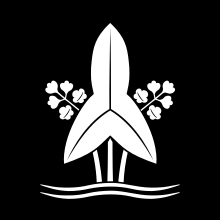Mizuno (clan)
The Mizuno ( Japanese 水 野 氏 , Mizuno-shi ) were a branched family of the Japanese sword nobility ( Buke ), which came from the province of Owari and which was traced back to Minamoto Mitsumasa ( Seiwa-Genji ). With an income of 50,000 koku , the Mizuno residing in Yamagata were among the larger Fudai daimyos of the Edo period .
genealogy
In the 15th century, Minamoto no Mitsusada settled in Mizuno ( Owari ) and took its name.
- Tadamasa ( 忠 政 , † 1543) resided successively in Okawa (Owari), Ōtaka (Owari) and in Kariya ( Mikawa ). His daughter Dai married Tokugawa Hidetada and became the mother of Ieyasu , creating a close bond. Tadamasa's sons started different branches.
Older branch
- Nobumoto ( 信元 , † 1576), Shimotsuke no kami , 1543 left the Imagawa to Oda Nobuhide , the father of Nobunaga to follow. This strained relations with the Tokugawa until they also joined the Oda. When Nobumoto got into an argument with Sakuma Nobumasa, Nobunaga ordered Ieyasu to execute Nobumoto, which he did.
- Tadashige ( 忠 重 , 1541–1600), a brother of Nobumoto, succeeded him. He served Toyotomi Hideyoshi , who gave him the title of Izumo no kami and increased his income to 40,000 koku. Tadashige was murdered by Kagai Hidemasu.
- Katsunari ( 勝 成 , 1564-1651), son of Tadashiges, took part in the Kyushu campaign of 1587 under the leadership of Sasa Narimasa. He took part in the Korean campaign , but behaved badly there. Upon his return, he joined Ieyasu and received the title Hyūga no kami . In 1615 he was transferred from Kariya to Yamatokōriyama with 60,000 koku and then in 1619 to Fukuyama (bingo) with 100,000 koku. In 1638, Katsushige helped put down the Shimabara uprising . In 1646 he shaved his head and took the monk name Sōkyū. - The direct line ended in 1698, an heir was chosen from the relatives. In 1703 the family was transferred to Yūki (Shimousa) with 17,000 koku, where they resided until 1868. Then Vice Count .
1. Younger branch
Tadatomo, a grandson of Tadashige, founded a branch that resided in Obata (Kōzuke) from 1602 and then in Kariya from 1616, in Yoshida (Mikawa) from 1632, in Matsumoto ( Shinano ) from 1642 , and Numazu (Suruga) from 1777 with 50,000 Koku. At the end of the Tokugawa period, the family was transferred to Kikuma ( Kazusa ). After 1868 Vice Count.
2. Younger branch
Tadamasu, another grandson of Tadashige, founded a branch that initially resided in Minakami ( Tamba ), then in Hōjō ( Awa ) and from 1827 to 1868 in a permanent house in Tsurumaki ( Kazusa ) with 15,000 koku. Then Vice Count.
3. Younger branch
Tadamori, a son of Tadamasa, founded a branch that resided in Yamakawa (Shimotsuke) from 1615, from 1635 in Tanaka ( Suruga ), from 1642 in Yoshida, from 1645 in Okazaki (Mikawa), from 1762 in Karatsu ( Hizen ) 1817 in Hamamatsu ( Tōtōmi ) and then from 1845 to 1868 in Yamagata with 50,000 Koku. The last daimyo was
- Tadahiro ( 忠 弘 , 1856–1905), after 1868 Vice Count.
4. Younger branch
Shigenaka ( 重 央 ; 1570-1621), a grandson of Tadamasas, was appointed by the shogunate house elder ( otsukegarō ) with the Kii-Tokugawa , was promoted to daimyo. He and his descendants resided in Shingū ( Kii ) with 35,000 Koku from 1619 until 1868. Then Vice Count.
Remarks
- ↑ The Mizuno used the standing frog spoon ( 沢 瀉 , omodaka ) in different variants as a coat of arms . The 4th branch, however, chose a coin as a coat of arms.
- ↑ Today the district of Ichihara .
- ↑ Today a district of Tateyama .
Individual evidence
- ↑ a b c Miura, Masayuki (ed.): Shiro to jinya. Tokoku-hen. Gakken, 2006. ISBN 978-4-05-604378-5 .
- ↑ a b Excerpts from the district maps "Shiba" and "Ichigaya" from approx. 1850.
literature
- Edmond Papinot: Historical and Geographical Dictionary of Japan. Reprint of the 1910 edition. Tuttle, 1972, ISBN 0-8048-0996-8 .
- Saichiro Miyaji (Ed.): Bakumatsu shoshu saigo-no hanchu-tachi. Saikoku-hen. Jinbunsha, 1997, ISBN 978-4-7959-1905-1 .






